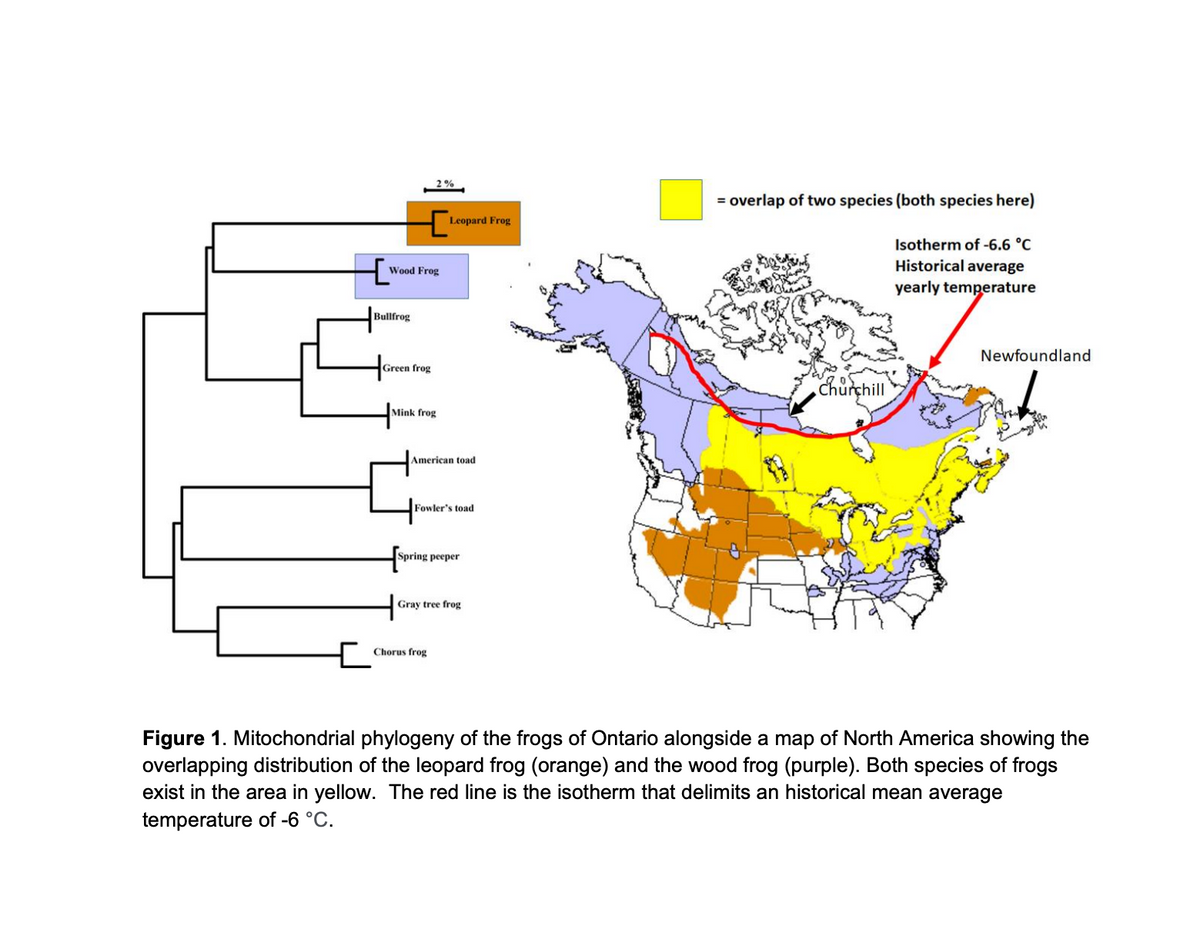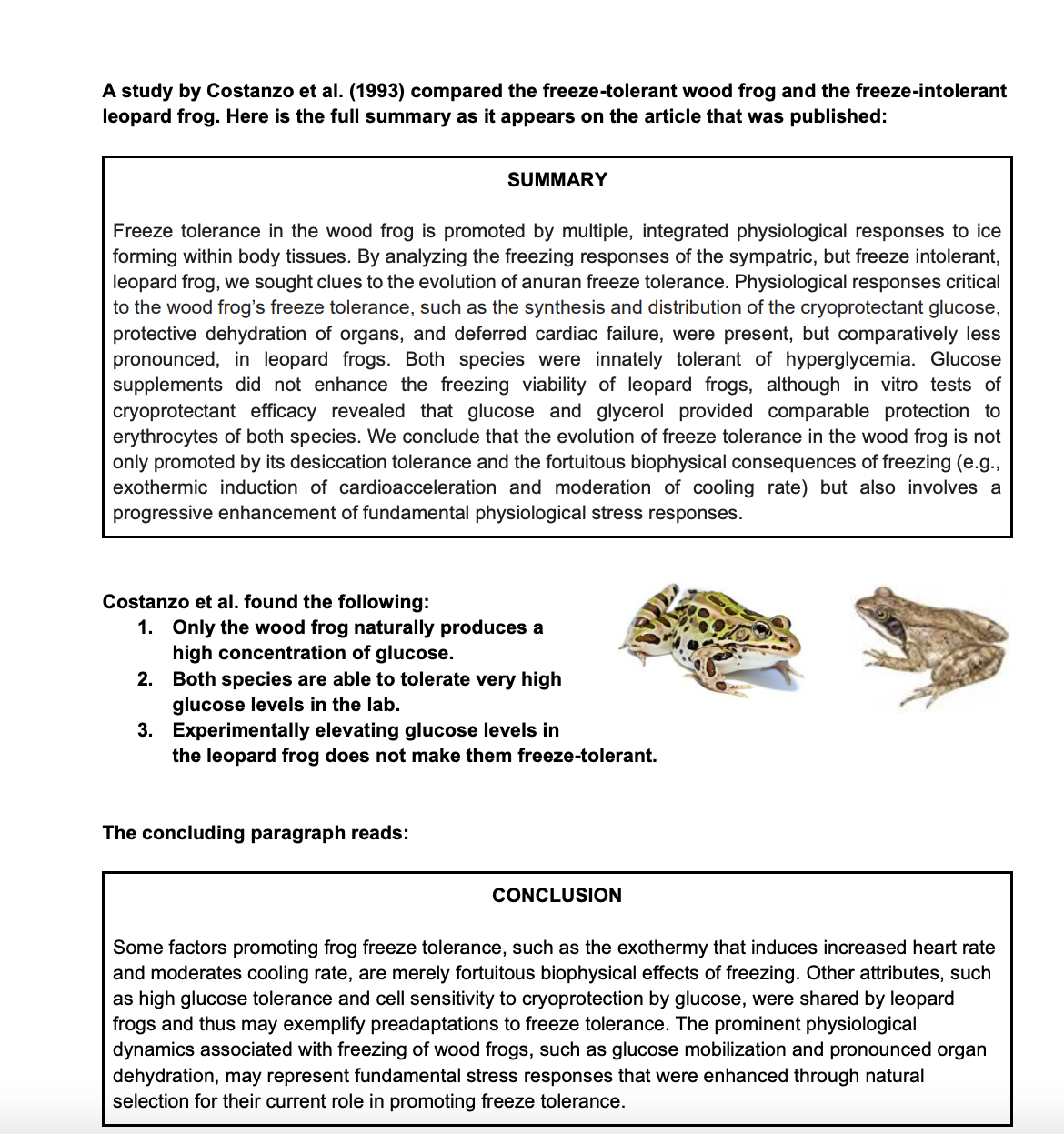Is the following statement consistent with the provided data? Answer TRUE if the statement is consistent with the data. Answer FALSE if the statement is not consistent with the data. 1. The evolution of freeze tolerance involves some factors that were not shaped directly by natural selection. 2. Because of their freeze tolerance, wood frogs may colonise more of the remainder of the island of Newfoundland than the leopard frog. 3. The distribution of the wood frog and leopard frog supports character displacement as a plausible hypothesis for why they overlap.
Is the following statement consistent with the provided data? Answer TRUE if the statement is consistent with the data. Answer FALSE if the statement is not consistent with the data. 1. The evolution of freeze tolerance involves some factors that were not shaped directly by natural selection. 2. Because of their freeze tolerance, wood frogs may colonise more of the remainder of the island of Newfoundland than the leopard frog. 3. The distribution of the wood frog and leopard frog supports character displacement as a plausible hypothesis for why they overlap.
Biology: The Dynamic Science (MindTap Course List)
4th Edition
ISBN:9781305389892
Author:Peter J. Russell, Paul E. Hertz, Beverly McMillan
Publisher:Peter J. Russell, Paul E. Hertz, Beverly McMillan
Chapter24: Systematics And Phylogenetics: Revealing The Tree Of Life
Section: Chapter Questions
Problem 1ITD: The phylogenetic tree for 12 cat species (Felidae) reproduced at right was assembled from molecular...
Related questions
Question
Is the following statement consistent with the provided data?
Answer TRUE if the statement is consistent with the data.
Answer FALSE if the statement is not consistent with the data.
1. The evolution of freeze tolerance involves some factors that were not shaped directly by natural selection.
2. Because of their freeze tolerance, wood frogs may colonise more of the remainder of the island of Newfoundland than the leopard frog.
3. The distribution of the wood frog and leopard frog supports character displacement as a plausible hypothesis for why they overlap.

Transcribed Image Text:C
Wood Frog
Bullfrog
1
Green frog
Mink frog
Leopard Frog
American toad
Fowler's toad
Spring peeper
Chorus frog
Gray tree frog
= overlap of two species (both species here)
Isotherm of -6.6 °C
Historical average
yearly temperature
Churchill
Newfoundland
Figure 1. Mitochondrial phylogeny of the frogs of Ontario alongside a map of North America showing the
overlapping distribution of the leopard frog (orange) and the wood frog (purple). Both species of frogs
exist in the area in yellow. The red line is the isotherm that delimits an historical mean average
temperature of -6 °C.

Transcribed Image Text:A study by Costanzo et al. (1993) compared the freeze-tolerant wood frog and the freeze-intolerant
leopard frog. Here is the full summary as it appears on the article that was published:
SUMMARY
Freeze tolerance in the wood frog is promoted by multiple, integrated physiological responses to ice
forming within body tissues. By analyzing the freezing responses of the sympatric, but freeze intolerant,
leopard frog, we sought clues to the evolution of anuran freeze tolerance. Physiological responses critical
to the wood frog's freeze tolerance, such as the synthesis and distribution of the cryoprotectant glucose,
protective dehydration of organs, and deferred cardiac failure, were present, but comparatively less
pronounced, in leopard frogs. Both species were innately tolerant of hyperglycemia. Glucose
supplements did not enhance the freezing viability of leopard frogs, although in vitro tests of
cryoprotectant efficacy revealed that glucose and glycerol provided comparable protection to
erythrocytes of both species. We conclude that the evolution of freeze tolerance in the wood frog is not
only promoted by its desiccation tolerance and the fortuitous biophysical consequences of freezing (e.g.,
exothermic induction of cardioacceleration and moderation of cooling rate) but also involves a
progressive enhancement of fundamental physiological stress responses.
Costanzo et al. found the following:
1. Only the wood frog naturally produces a
high concentration of glucose.
2.
Both species are able to tolerate very high
glucose levels in the lab.
3.
Experimentally elevating glucose levels in
the leopard frog does not make them freeze-tolerant.
The concluding paragraph reads:
CONCLUSION
Some factors promoting frog freeze tolerance, such as the exothermy that induces increased heart rate
and moderates cooling rate, are merely fortuitous biophysical effects of freezing. Other attributes, such
as high glucose tolerance and cell sensitivity to cryoprotection by glucose, were shared by leopard
frogs and thus may exemplify preadaptations to freeze tolerance. The prominent physiological
dynamics associated with freezing of wood frogs, such as glucose mobilization and pronounced organ
dehydration, may represent fundamental stress responses that were enhanced through natural
selection for their current role in promoting freeze tolerance.
Expert Solution
This question has been solved!
Explore an expertly crafted, step-by-step solution for a thorough understanding of key concepts.
Step by step
Solved in 2 steps

Knowledge Booster
Learn more about
Need a deep-dive on the concept behind this application? Look no further. Learn more about this topic, biology and related others by exploring similar questions and additional content below.Recommended textbooks for you

Biology: The Dynamic Science (MindTap Course List)
Biology
ISBN:
9781305389892
Author:
Peter J. Russell, Paul E. Hertz, Beverly McMillan
Publisher:
Cengage Learning

Biology: The Unity and Diversity of Life (MindTap…
Biology
ISBN:
9781305073951
Author:
Cecie Starr, Ralph Taggart, Christine Evers, Lisa Starr
Publisher:
Cengage Learning

Biology Today and Tomorrow without Physiology (Mi…
Biology
ISBN:
9781305117396
Author:
Cecie Starr, Christine Evers, Lisa Starr
Publisher:
Cengage Learning

Biology: The Dynamic Science (MindTap Course List)
Biology
ISBN:
9781305389892
Author:
Peter J. Russell, Paul E. Hertz, Beverly McMillan
Publisher:
Cengage Learning

Biology: The Unity and Diversity of Life (MindTap…
Biology
ISBN:
9781305073951
Author:
Cecie Starr, Ralph Taggart, Christine Evers, Lisa Starr
Publisher:
Cengage Learning

Biology Today and Tomorrow without Physiology (Mi…
Biology
ISBN:
9781305117396
Author:
Cecie Starr, Christine Evers, Lisa Starr
Publisher:
Cengage Learning

Biology: The Unity and Diversity of Life (MindTap…
Biology
ISBN:
9781337408332
Author:
Cecie Starr, Ralph Taggart, Christine Evers, Lisa Starr
Publisher:
Cengage Learning